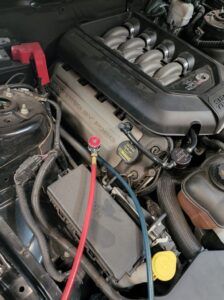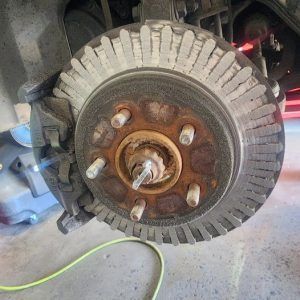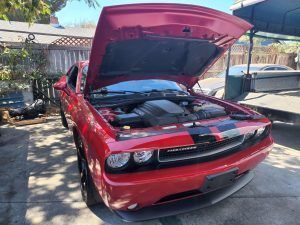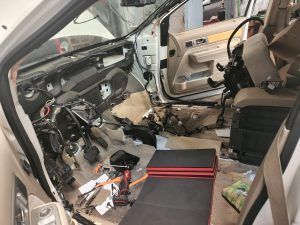A Car Breakdown: Top Common Auto Repairs To Know
Are you prepared for the unexpected? Breakdowns happen, and when they do, it’s crucial to have the knowledge and skills to handle common auto repairs.
In this article, we will guide you through the top common auto repairs to know when dealing with a car breakdown. From a dead battery to faulty alternators, engine overheating, and brake issues, we have got you covered.
By understanding these repairs, you will be equipped to tackle them head-on, saving time, money, and frustration. No need to panic when your car breaks down; with our expert advice, you will be able to confidently diagnose and fix the problem.
So, buckle up and get ready to become your own car repair expert. Let’s dive into the world of auto repairs and ensure you never get stranded on the road again.
Key Takeaways
– Knowledge and skills for common auto repairs are important for dealing with car breakdowns.
– Dealing with a dead battery includes jump-starting the car.
– Recognizing signs of a dead battery and knowing when to replace it is crucial.
– Maintaining tire pressure and regularly rotating tires is essential for smooth journeys.
Dead Battery
If you find yourself with a dead battery, don’t panic – it’s a common issue that can be easily resolved. One of the first things you can try is to jump-start your car. To do this, you’ll need a set of jumper cables and another vehicle with a working battery. Connect the positive terminals of both batteries with the red cable, and then connect the negative terminal of the working battery with the black cable.
Start the working vehicle and let it run for a few minutes, then try starting your car. If this doesn’t work, it may be time for a battery replacement. Car batteries typically last around three to five years, so if yours is older than that or you’ve been experiencing frequent battery issues, it’s likely time for a new one.
You can purchase a replacement battery at an auto parts store or have it installed by a professional.
Now, let’s move on to the next common issue – the flat tire.
Flat Tire
Changing a flat tire is a skill every driver should have to ensure a smooth and uninterrupted journey. When faced with a flat tire, it is important to first assess the tire pressure. Use a tire pressure gauge to determine if the tire is simply deflated or if there is a puncture. If the tire pressure is low but there are no visible signs of damage, it may just need to be inflated. However, if there is a puncture, it will need to be repaired or replaced. Tire rotation is another crucial aspect of tire maintenance. It involves moving each tire to a different position on the vehicle to ensure even wear. This can extend the lifespan of the tires and improve overall performance.
To help you visualize the importance of tire pressure and rotation, here is a table:
| Tire Pressure | Tire Rotation |
|—————|—————|
| Proper tire pressure ensures optimal handling and fuel efficiency. | Regular tire rotation promotes even wear and extends tire lifespan. |
| Low tire pressure can lead to decreased traction and increased risk of a blowout. | Uneven tire wear can cause handling issues and compromise safety. |
| Overinflated tires reduce contact with the road, resulting in a harsher ride. | Neglecting tire rotation can lead to premature tire replacement. |
Now that you understand the significance of tire pressure and rotation, it’s crucial to address another common auto repair issue: a faulty alternator.
Faulty Alternator
If you suspect your alternator may be faulty, there are a few key signs to look out for. These include dimming headlights, a dead battery, and unusual noises coming from the engine. To diagnose and repair a faulty alternator, you’ll need to use a multimeter to test the electrical output and determine if it’s functioning properly.
Preventive measures to avoid alternator issues include regularly checking the battery and electrical system, avoiding overloading the electrical system, and replacing the alternator belt as recommended by your vehicle’s manufacturer.
Signs of a faulty alternator
When your car’s lights start flickering and your radio keeps cutting out, it’s a clear sign that your alternator might be faulty. Here are five signs to look out for when troubleshooting your alternator:
– Dimming lights: If your headlights or interior lights aren’t as bright as they should be, it could indicate a problem with the alternator.
– Dead battery: A dead battery, especially if it keeps dying, could be a result of a faulty alternator not properly charging it.
– Strange noises: If you hear grinding or whining sounds coming from the engine, it could be a sign that the alternator is failing.
– Warning light: The battery warning light on your dashboard is designed to alert you to potential alternator issues.
– Electrical issues: Problems with your car’s electrical components, such as power windows or the air conditioning, can be attributed to a faulty alternator.
Knowing these signs will help you diagnose and repair a faulty alternator more effectively.
How to diagnose and repair a faulty alternator
First, you’ll need to gather the necessary tools and prepare yourself to diagnose and repair a faulty alternator. Start by disconnecting the negative battery cable to prevent any electrical shock.
Then, use a multimeter to test the voltage output of the alternator. If the reading is below the recommended range, it indicates a faulty alternator.
Next, inspect the alternator belt for any signs of wear or damage and replace it if necessary.
If the alternator needs replacement, disconnect the electrical connectors and mounting bolts before removing it from the vehicle. Install the new alternator and reconnect the electrical connectors and mounting bolts.
Finally, reconnect the negative battery cable and start the engine to ensure that the alternator is working properly.
Now, let’s move on to preventive measures to avoid alternator issues.
Preventive measures to avoid alternator issues
To avoid alternator issues, it’s important to regularly check and maintain the condition of your vehicle’s electrical system. The alternator is a crucial component that charges the battery and powers the electrical devices in your car. Neglecting its maintenance can lead to common alternator problems such as a dead battery, dimming headlights, or difficulty starting the engine. To keep your alternator in good working condition, follow these preventive measures:
| Alternator Maintenance | Common Alternator Problems |
| ————————— | ————————- |
| Check belt tension | Dead battery |
| Inspect wiring connections | Dimming headlights |
| Clean battery terminals | Difficulty starting |
| Test alternator output | Engine stalling |
| Replace worn-out components | Strange noises |
Regularly performing these tasks will ensure that your alternator functions optimally and extends its lifespan. By taking proactive measures, you can prevent alternator issues and maintain a reliable electrical system in your vehicle. Moving on to engine overheating, it’s crucial to address this issue promptly to avoid further damage.
Engine Overheating
When your engine starts to overheat, there are several key signs to look out for. These can include a rising temperature gauge, steam coming from under the hood, and a strong smell of coolant.
To prevent engine overheating, make sure to regularly check and maintain your coolant levels, ensure proper airflow to the radiator, and keep an eye on any warning lights or gauges.
If your engine does overheat, it’s important to take immediate action by pulling over to a safe location, turning off the engine, and allowing it to cool down before attempting any repairs.
Signs of an overheating engine
If your engine is running hotter than usual, it’s a sign of an overheating engine. This is a serious issue that requires immediate attention. Here are some signs to look out for:
– Steam coming from the hood: This indicates that the engine is overheating and coolant may be leaking.
– Strange smells: If you notice a sweet or burnt smell, it could be a sign of a coolant leak.
– Temperature gauge in the red zone: If the temperature gauge on your dashboard is indicating a high temperature, it’s a clear sign of an overheating engine.
Knowing these signs can help you take action promptly and prevent further damage to your vehicle.
In the next section, we will discuss how to prevent engine overheating without compromising your journey.
How to prevent engine overheating
One effective way to avoid engine overheating is by regularly maintaining your vehicle’s cooling system. Proper cooling system maintenance includes checking and topping off coolant levels, inspecting hoses and belts for any signs of wear or leaks, and ensuring that the radiator is clean and free from debris.
In addition, it’s recommended to perform a radiator flush periodically to remove any built-up sediment or contaminants that could impede the cooling system’s efficiency. A radiator flush involves draining the old coolant, flushing the system with a cleaning solution, and refilling it with fresh coolant.
By taking these preventive measures and keeping your cooling system in optimal condition, you can greatly reduce the risk of engine overheating. This will help to ensure the longevity and performance of your vehicle.
Now, let’s move on to the next section about steps to take when your engine overheats.
Steps to take when your engine overheats
To effectively address an overheating engine, it’s crucial to take immediate action and follow these steps:
– **Assess the situation**: Pay attention to signs of an overheating engine, such as steam coming from the hood or a temperature gauge in the red zone.
– **Pull over safely**: Find a safe spot to park your car and turn off the engine. Do not open the radiator cap while the engine is still hot, as it can cause severe burns.
– **Allow the engine to cool**: Give the engine ample time to cool down before attempting any further actions. Opening the hood too soon can release scalding steam.
– **Check coolant levels**: Once the engine has cooled, carefully check the coolant levels. If they are low, add coolant or water to the radiator.
– **Seek professional help**: If the engine continues to overheat or you are unsure about what to do, it’s best to call for roadside assistance or a professional mechanic.
Now, let’s move on to the next section about brake issues.
Brake Issues
Brake issues can often be detected through a noticeable decrease in stopping power or a high-pitched squealing noise during braking. If you experience either of these symptoms, it’s important to address the problem promptly to ensure your safety on the road.
Understanding brake maintenance and brake system troubleshooting can help you diagnose and resolve the issue efficiently.
Regular brake maintenance is crucial to keep your braking system in optimal condition. This includes checking the brake pads for wear and tear, as well as inspecting the brake fluid level and quality. If you notice any signs of deterioration, such as thinning brake pads or discolored brake fluid, it’s advisable to have them replaced or serviced by a professional mechanic.
When troubleshooting brake issues, it’s essential to identify the underlying cause accurately. The most common reasons for brake problems include worn-out brake pads, damaged rotors, or a malfunctioning brake caliper. By examining these components thoroughly, you can pinpoint the specific issue and take appropriate action.
Remember, your brakes are a vital safety feature of your vehicle. Ignoring brake issues can lead to further damage and potentially dangerous situations on the road. If you’re unsure about how to address brake problems, it’s always best to consult with a qualified mechanic who can provide expert advice and assistance.
Frequently Asked Questions
How do I know if my car battery is dead or just needs a jumpstart?
To determine if your car battery is dead or just needs a jumpstart, look for signs of a weak car battery such as dim headlights, difficulty starting the engine, or a clicking sound when you turn the key. Regular car battery maintenance can help prevent these issues.
Can I repair a flat tire on my own or do I need to call for roadside assistance?
Repairing a flat tire on your own is possible but requires proper tools and skills. Pros of calling for roadside assistance include convenience and safety. Cons include potential wait times and possible costs depending on your coverage.
What are the signs of a faulty alternator and how can I diagnose it?
To diagnose a faulty alternator, look for signs of alternator failure such as dimming headlights, a dead battery, or strange noises. Use a multimeter to test the alternator’s voltage output.
What should I do if my car engine starts overheating while I’m driving?
If your car engine starts overheating while driving, immediately pull over to a safe location and turn off the engine. Allow it to cool before checking coolant levels and radiator. To prevent overheating, ensure regular maintenance, proper coolant levels, and a functioning cooling system.
How often should I have my car’s brakes checked for potential issues?
You should have your car’s brake pads checked every 20,000 to 30,000 miles or as recommended by your vehicle’s manufacturer. Common signs of brake issues include squeaking, grinding, or a soft brake pedal.
Conclusion
In conclusion, being knowledgeable about common auto repairs is essential for dealing with car breakdowns. Knowing how to handle a dead battery, flat tire, faulty alternator, engine overheating, and brake issues can make a significant difference in resolving the problem efficiently.
Remember to stay calm and follow the necessary steps to address these issues correctly. By familiarizing yourself with these common repairs, you can save time, money, and stress when faced with a car breakdown.







